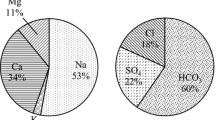Abstract
In India, the quantity and quality of water available for irrigation is variable from place to place. Assessment of water quality has been carried out to determine the sources of dissolved ions in groundwater. Quality of groundwater in a 398 km2 Peddavanka watershed of a semi-arid region of south India is evaluated for its suitability for drinking and irrigation purposes. The middle Proterozoic Cuddapah Supergroup and Kurnool Group of rocks underlie most of the watershed. The main lithologic units consist chiefly of quartzite, limestone, and shale. Seventy-six water samples were collected from open-wells and bore-holes. Water samples were collected representative of the post-monsoon (winter) and pre-monsoon (summer). The quality assessment is made through the estimation of Ca2+, Mg2+, Na+, K+, Cl−, SO 2−4 , CO 2−3 , HCO −3 , total hardness as CaCO3, TDS, EC, and pH. Based on these analyses, parameters like sodium adsorption ratio, % sodium, residual sodium carbonate, non-carbonate hardness, potential salinity, Kelley’s ratio, magnesium ratio, index of base exchange and permeability index were calculated. According to Gibbs‘ ratio samples in both seasons fall in the rock dominance field. The overall quality of waters in the study area in post-monsoon season is high for all constituents ruling out pollution from extraneous sources.










Similar content being viewed by others
References
APHA (1995) Standard methods for the examination of water and wastewater, 19th ed. American Public Health Association, Washington, D.C., 1,467 pp
Ayers RS, Westcot DW (1985) Water quality for agriculture, FAO of the United Nations, Paper 19, Rome, Italy
Gibbs RJ (1970) Mechanisms controlling World’s water chemistry, Science, volt 170, pp 1088- 1090
Gowd SS (1998) Evaluation and management of water resources: a case study of Peddavanka watershed, Anantapur District, A.P., India. Unpubl. Ph.D thesis, S.V. University, Tirupati, India
Hem JD (1991) Study and interpretation of the chemical characteristics of natural water, 3rd edn. Book 2254, Scientific Publ. Jodhpur, India.
IS: 11624 (1986) Guidelines for quality of irrigation water, Bureau of Indian Standards, New Delhi
Johnson CC (1979) Land application of water-an accident waiting to happen. Groundwater 17(1):69–72
Kelley WP (1951) Alkali Soils-their formation properties and reclamation. Reinhold Pub, New York
Kuchanwar OD, Kale CK, Deshpande VP, Dharmadhikari DM (1999) Irrigation water quality and farm management decisions. Water Sci Tech 40(2):97–103
Murthy YGK, Setti TLN, Rajurkar ST, Meoloi SH, Nagaraja Rao BK, Ramaligaswami G, Madan Mohan B, Ravindra Babu R (1979) Salient features of the revised geological map of the Cuddapah basin. Third workshop on status and problems in Indian Peninsular shield, Indian Inst. Peninsular Geol., Hyderabad
Ramam PK, Murty VN (1997) Geology of Andhra Pradesh, Geol, Soc. India. Bangalore 245 pp
Rhodes JD (1972) Quality of water for irrigation. Soil Sci 113(4):227–234
Sastri JCV (1994) Groundwater chemical quality in river basins, Hydrogeochemical modeling. Lecture notes-Refresher course, School of Earth Sciences, Bharathidasan Univ., Tiruchirapalli, Tamil Nadu, India
Schoeller H (1977) Geochemistry of groundwater. Ch. 15, pp 1–18 In: Groundwater studies-An International guide for research and practice, UNESCO, Paris
Singh H (1983) Crop production in India. Agri Situation in India 38:635–639
Todd DK (1995) Groundwater Hydrology. John Wiley& Sons Inc., New York, pp 538
USEPA (1992) Guidelines for water use. USEPA, Washington, Tech. Report 81, pp 252
WHO (1989) Health Guidelines for the Use of Wastewater in Agriculture and Aquaculture. Report of a WHO Scientific Group – Technical Report Series 778, WHO Geneva, 74 pp
Wilcox LV (1955) Classification and use of irrigation waters. USDA Circular No.969, 19pp
Acknowledgements
I gratefully acknowledge Dr.V.P.Dimri, Director, NGRI, for his constant encouragement and permission to publish this work. I wish to express my gratitude to Dr.P.K. Govil, Head, Environmental Geochemistry, Dr. M.N. Rao, and Dr. D. Muralidharan, NGRI, for their constructive comments and useful suggestions. The financial assistance provided by Council of Scientific and Industrial Research (CSIR), New Delhi, by awarding Research Associate fellowship is gratefully acknowledged. I thank anonymous reviewers for their constructive review of the manuscript and I am very much grateful to the Editor for editorial revision.
Author information
Authors and Affiliations
Corresponding author
Rights and permissions
About this article
Cite this article
Gowd, S.S. Assessment of groundwater quality for drinking and irrigation purposes: a case study of Peddavanka watershed, Anantapur District, Andhra Pradesh, India. Environ Geol 48, 702–712 (2005). https://doi.org/10.1007/s00254-005-0009-z
Received:
Accepted:
Published:
Issue Date:
DOI: https://doi.org/10.1007/s00254-005-0009-z




